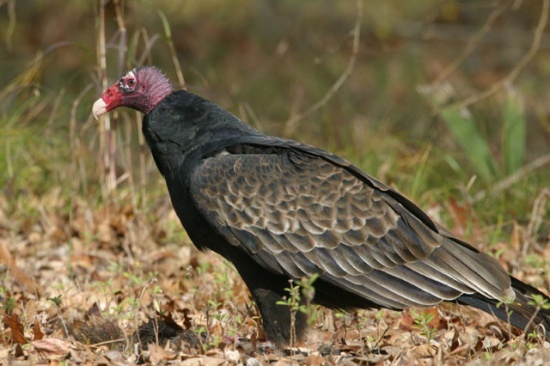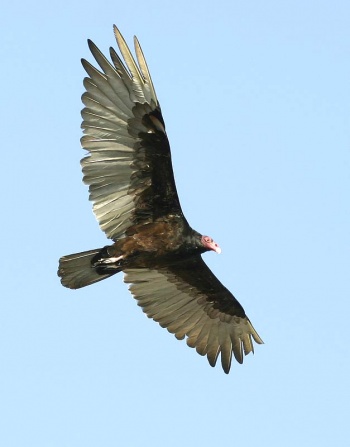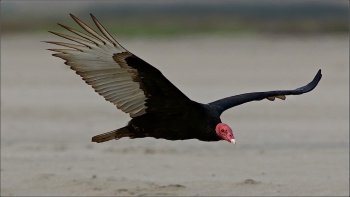BigRedBirder (talk | contribs) |
(taxon, refs) |
||
| (17 intermediate revisions by 9 users not shown) | |||
| Line 1: | Line 1: | ||
| − | + | [[Image:Turkey_Vulture.jpg|thumb|550px|right|Adult Photo © by {{user|Vogelman|Vogelman}} <br />Montgomery County, [[Texas]] 26 December 2003]] | |
| − | [[Image:Turkey_Vulture.jpg|thumb|550px|right|Photo by Vogelman]] | + | ;[[Category:Cathartes]] [[:Category:Cathartes|Cathartes]] aura |
| + | |||
==Identification== | ==Identification== | ||
| − | *Large and | + | 62–81 cm (24½-31¾ in) |
| − | *Primaries spread during flight (resembling fingers) | + | *Large and brown to blackish |
| + | *[[Topography#Wings|Primaries]] spread during flight (resembling fingers) | ||
*Flight feathers appear silvery below | *Flight feathers appear silvery below | ||
| − | + | *Naked pink head (color differ among subspecies) | |
| − | *Naked pink head | ||
====Similar Species==== | ====Similar Species==== | ||
May be confused with [[Black Vulture]]. Separating features: | May be confused with [[Black Vulture]]. Separating features: | ||
| − | + | [[Image:Turkey_Vulture_flight_by_Nick_Richter.jpg|thumb|350px|right|Subspecies ''aura''<br />Photo © by {{user|Nick_Richter|Nick Richter}} <br />Irvine, [[California]], 27 June 2004]] | |
| − | *head: | + | *head: grayish in Black Vulture and red in adult Turkey. |
| − | *underwing: Turkey | + | ** juvenile Turkey Vulture has dark head similar to Black Vulture, but feathers almost reach chin. Black vulture has bare throat. |
| + | *underwing: Turkey has silvery secondaries and primaries when seen from below, contrasting with the dark underwing coverts; Black Vulture has white primaries contrasting to both coverts and secondaries as seen from both above and below. | ||
*tail: longer in Turkey (make wings appear narrower). | *tail: longer in Turkey (make wings appear narrower). | ||
| + | *flight: Black Vulture holds wings nearly flat | ||
==Distribution== | ==Distribution== | ||
| − | North, Central and South America. Breeds in the south of Canada from southern British Columbia to southern Ontario, almost throughout the | + | [[North America|North]], [[Central America|Central]] and [[South America]]. |
| − | A summer visitor to much of North American range but resident further south. Northern birds winter in the southern | + | |
| + | Breeds in the south of [[Canada]] from southern [[British Columbia]] to southern [[Ontario]], almost throughout the [[United States]] except the far northeast, in [[Mexico]], [[Central America]], part of the [[Bahamas]] and the [[Greater Antilles]] east to [[Puerto Rico]], and in [[South America]] from [[Colombia]] and [[Venezuela]] south to [[Tierra del Fuego]] and the [[Falkland Islands]] but rare or absent from much of eastern [[Argentina]]. Scarce in the far north but increasing and expanding range. | ||
| + | A summer visitor to much of North American range but resident further south. | ||
| + | |||
| + | Northern birds winter in the southern [[United States]] from central [[California]] to [[Florida]] and southwards. Southernmost birds include some migratory populations. | ||
==Taxonomy== | ==Taxonomy== | ||
| − | + | [[Image:Turkey Vulture Cathartes aura jota .jpg|thumb|350px|right|Subspecies ''jota''<br />Photo © by {{user|Stanley+Jones|Stanley Jones}}<br />Playa El Paraíso, Huaura Province, [[Peru]], 30 August 2017]] | |
| − | + | ====Subspecies==== | |
| − | + | Clements recognizes these subspecies[[#References|[1]]]: | |
| − | + | *''C.a. aura'': southern [[California]] eastward to southern [[Texas]] (southwestern [[USA]]) southward to northern [[Costa Rica]] and [[Greater Antilles]] | |
| − | + | *''C.a. meridionalis'': breeds southern [[British Colombia]] eastward to southern [[Manitoba]] and southward to central [[California]] and south-central [[Texas]]; winters to central [[South America]] | |
| + | *''C.a. septentrionalis'': in eastern [[North America]] | ||
| + | *''C.a. ruficollis'': in Trinidad and from [[Panama]] to northern [[Argentina]] | ||
| + | *''C.a. jota'': from [[Colombia]] to Patagonia and the [[Falkland Islands]] | ||
| + | Some sources mention at least two more subspecies[[#References|[3]]]. There is also a suspicion that this species should be studied further because more than one species might be involved. | ||
| + | ==Habitat== | ||
| + | A wide range of habitats from deserts, plains and mountains to forest and jungle. Cruises over all terrestrial and shoreline habitat | ||
| − | |||
| − | |||
==Behaviour== | ==Behaviour== | ||
| − | == | + | ====Action==== |
| + | Rocking flight with wings held in dihedral (v-shaped) | ||
| + | ====Diet==== | ||
| + | Often scavenges at refuse-tips and along roadsides and shorelines. | ||
| + | ====Breeding==== | ||
| + | Nest usually among boulders or cliffs, but also in hollow logs on forest floor. | ||
| + | ====Vocalisation==== | ||
Hisses and grunts given at the nest | Hisses and grunts given at the nest | ||
| + | ====Movements==== | ||
| + | North American races almost wholly migratory, moving to southern USA and funneling through Middle America to South America where they mingle with resident populations during the winter. | ||
| + | |||
| + | ==References== | ||
| + | #{{Ref-Clements6thOct24}}#{{Ref-GillDonskerRasmussen24V14.2}}#{{Ref-Jaramillo03}}#Global Raptor Information Network. 2020. Species account: Turkey Vulture Cathartes aura. Downloaded from http://www.globalraptors.org on 24 Feb. 2020. | ||
| + | #Houston, D., Kirwan, G.M., Christie, D.A. & Marks, J.S. (2020). Turkey Vulture (''Cathartes aura''). In: del Hoyo, J., Elliott, A., Sargatal, J., Christie, D.A. & de Juana, E. (eds.). Handbook of the Birds of the World Alive. Lynx Edicions, Barcelona. (retrieved from https://www.hbw.com/node/52940 on 24 February 2020). | ||
| + | #Kirk, D. A. and M. J. Mossman (1998). Turkey Vulture (''Cathartes aura''), version 2.0. In The Birds of North America (A. F. Poole and F. B. Gill, Editors). Cornell Lab of Ornithology, Ithaca, NY, USA. https://doi.org/10.2173/bna.339 | ||
| + | {{ref}} | ||
| + | |||
==External Links== | ==External Links== | ||
| − | {{GSearch|Cathartes | + | {{GSearch|"Cathartes aura" {{!}} "Turkey Vulture"}} |
| + | {{GS-checked}}1 | ||
| + | <br /> | ||
| + | <br /> | ||
[[Category:Birds]] | [[Category:Birds]] | ||
Latest revision as of 02:09, 5 January 2025
- Cathartes aura
Identification
62–81 cm (24½-31¾ in)
- Large and brown to blackish
- Primaries spread during flight (resembling fingers)
- Flight feathers appear silvery below
- Naked pink head (color differ among subspecies)
Similar Species
May be confused with Black Vulture. Separating features:
- head: grayish in Black Vulture and red in adult Turkey.
- juvenile Turkey Vulture has dark head similar to Black Vulture, but feathers almost reach chin. Black vulture has bare throat.
- underwing: Turkey has silvery secondaries and primaries when seen from below, contrasting with the dark underwing coverts; Black Vulture has white primaries contrasting to both coverts and secondaries as seen from both above and below.
- tail: longer in Turkey (make wings appear narrower).
- flight: Black Vulture holds wings nearly flat
Distribution
North, Central and South America.
Breeds in the south of Canada from southern British Columbia to southern Ontario, almost throughout the United States except the far northeast, in Mexico, Central America, part of the Bahamas and the Greater Antilles east to Puerto Rico, and in South America from Colombia and Venezuela south to Tierra del Fuego and the Falkland Islands but rare or absent from much of eastern Argentina. Scarce in the far north but increasing and expanding range. A summer visitor to much of North American range but resident further south.
Northern birds winter in the southern United States from central California to Florida and southwards. Southernmost birds include some migratory populations.
Taxonomy
Subspecies
Clements recognizes these subspecies[1]:
- C.a. aura: southern California eastward to southern Texas (southwestern USA) southward to northern Costa Rica and Greater Antilles
- C.a. meridionalis: breeds southern British Colombia eastward to southern Manitoba and southward to central California and south-central Texas; winters to central South America
- C.a. septentrionalis: in eastern North America
- C.a. ruficollis: in Trinidad and from Panama to northern Argentina
- C.a. jota: from Colombia to Patagonia and the Falkland Islands
Some sources mention at least two more subspecies[3]. There is also a suspicion that this species should be studied further because more than one species might be involved.
Habitat
A wide range of habitats from deserts, plains and mountains to forest and jungle. Cruises over all terrestrial and shoreline habitat
Behaviour
Action
Rocking flight with wings held in dihedral (v-shaped)
Diet
Often scavenges at refuse-tips and along roadsides and shorelines.
Breeding
Nest usually among boulders or cliffs, but also in hollow logs on forest floor.
Vocalisation
Hisses and grunts given at the nest
Movements
North American races almost wholly migratory, moving to southern USA and funneling through Middle America to South America where they mingle with resident populations during the winter.
References
- Clements, J. F., P. C. Rasmussen, T. S. Schulenberg, M. J. Iliff, T. A. Fredericks, J. A. Gerbracht, D. Lepage, A. Spencer, S. M. Billerman, B. L. Sullivan, M. Smith, and C. L. Wood. 2024. The eBird/Clements checklist of Birds of the World: v2024. Downloaded from https://www.birds.cornell.edu/clementschecklist/download/
- Gill, F, D Donsker, and P Rasmussen (Eds). 2024. IOC World Bird List (v 14.2). Doi 10.14344/IOC.ML.14.2. http://www.worldbirdnames.org/
- Jaramillo, A. 2003. Birds of Chile. Princeton & Oxford: Princeton Univ. Press. ISBN 978-0691117409
- Global Raptor Information Network. 2020. Species account: Turkey Vulture Cathartes aura. Downloaded from http://www.globalraptors.org on 24 Feb. 2020.
- Houston, D., Kirwan, G.M., Christie, D.A. & Marks, J.S. (2020). Turkey Vulture (Cathartes aura). In: del Hoyo, J., Elliott, A., Sargatal, J., Christie, D.A. & de Juana, E. (eds.). Handbook of the Birds of the World Alive. Lynx Edicions, Barcelona. (retrieved from https://www.hbw.com/node/52940 on 24 February 2020).
- Kirk, D. A. and M. J. Mossman (1998). Turkey Vulture (Cathartes aura), version 2.0. In The Birds of North America (A. F. Poole and F. B. Gill, Editors). Cornell Lab of Ornithology, Ithaca, NY, USA. https://doi.org/10.2173/bna.339
Recommended Citation
- BirdForum Opus contributors. (2025) Turkey Vulture. In: BirdForum, the forum for wild birds and birding. Retrieved 10 February 2025 from https://www.birdforum.net/opus/Turkey_Vulture
External Links
GSearch checked for 2020 platform.1






